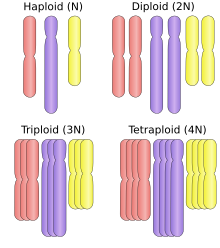同源多倍体
(重定向自三倍体)
同源多倍体是由某个细胞在分裂过程中姐妹染色单体或同源染色体分离失败使染色体数目加倍造成的多倍体。由于同源多倍体个体每个细胞中染色体组数可能为奇数,使它们在减数分裂中无法正确配对和平均分离,因而同源多倍体个体可能高度不育。

同源多倍体发生了正常染色体数的加倍,但是所有的染色体都来源于同一个物种,并且常常是来自同一个个体。同源多倍体可以源于有丝分裂异常,也可源于因减数第二次分裂失败而造成的二倍体配子。同源多倍体常常不育是因为减数分裂时3条或更多条同源染色体不能形成二价体(成对),而是形成多价体(3条或更多的联会染色体)。这使得分裂时发生染色体畸变,配子便不能包含一套完整的染色体。通过实验操作得到的人工同源多倍体往往比他们的二倍体亲本适合度低。

同源多倍体类型
编辑参考文献
编辑- ^ Bertolani R. Evolution of the reproductive mechanisms in Tardigrades: a review. Zoologischer Anzeiger. 2001, 240 (3–4): 247–252. doi:10.1078/0044-5231-00032.
- ^ Wendel J. F. Introduction to polyploid genome evolution and lessons from Gossypium. XVII International Botanical Congress. 2005.
- ^ Deanna J. Stouder; Peter A. Bisson; Robert J. Naiman. Pacific Salmon and Their Ecosystems: Status and Future Options. Springer. 1997: 30–31 [9 July 2013]. ISBN 978-0-412-98691-8.
- ^ The genetic origin of kiwifruit. http://www.actahort.org/books/297/297_5.htm (页面存档备份,存于互联网档案馆)
- ^ Ainouche M. L., Fortune P. M., Salmon A., Parisod C., Grandbastien M. A., Fukunaga K., Ricou M., Misset M. T. Hybridization, polyploidy and invasion: lessons from Spartina (Poaceae). Biological Invasions. 2009, 11 (5): 1159–1173. doi:10.1007/s10530-008-9383-2.